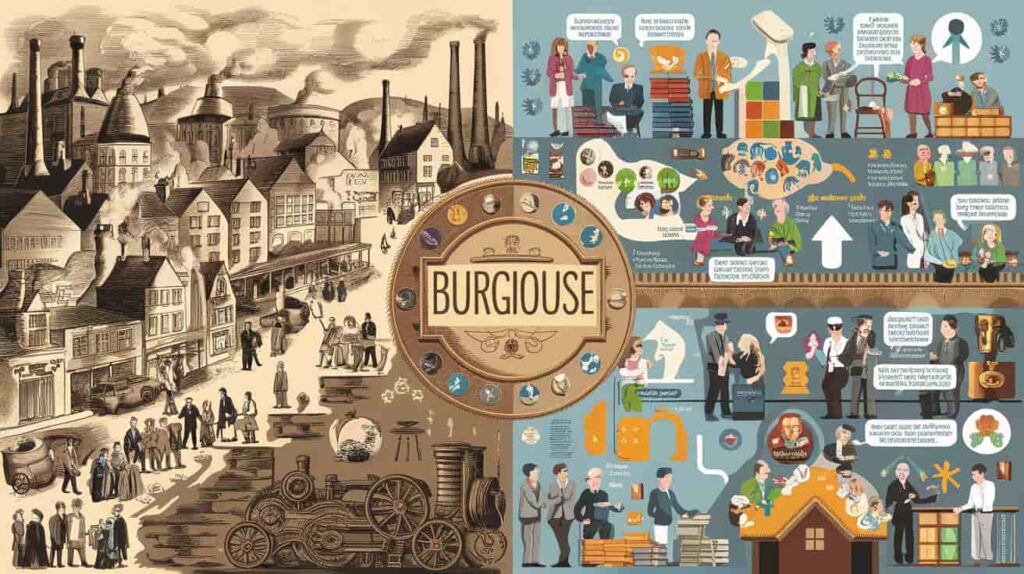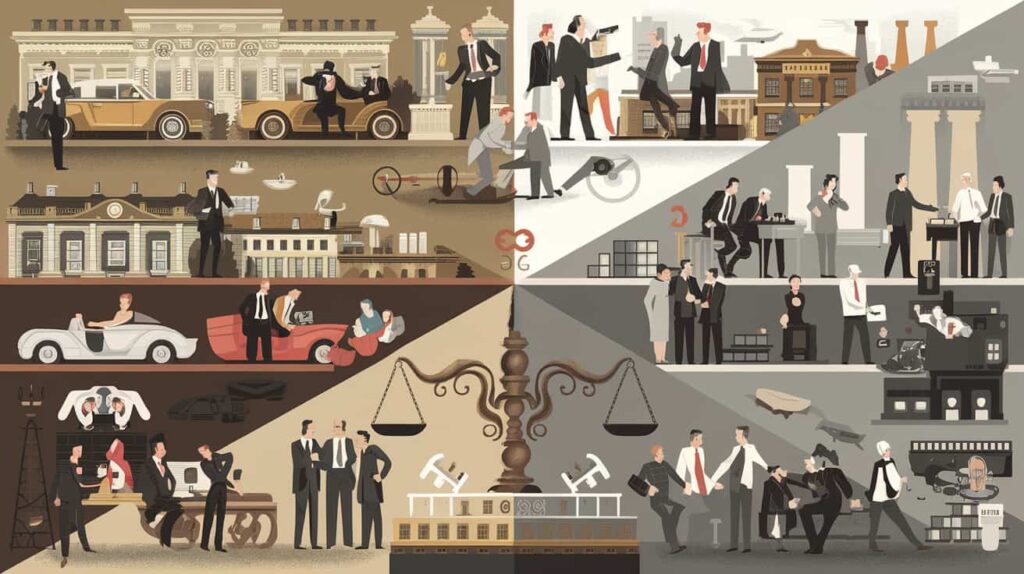When I first learned about burguiouse, it struck me how much my upbringing in a middle-class family shaped my views on success and community. It made me reflect on my journey and the values that guide my choices in a world often defined by wealth and status.
Burguiouse is a modern twist on the bourgeoisie, which describes the middle or wealthy class that became important during the Industrial Revolution. It reflects current conversations about social classes, wealth gaps, and cultural identity.
Stay tuned with us as we explore burguiouse and its impact on our lives today. We’ll discuss how this concept shapes our understanding of class and identity. You won’t want to miss the insights we have in store!
What Is Burguiouse? – Detailed Answer Here!
Burguiouse is a modern twist on the term bourgeoisie, originally describing the middle or wealthy class that emerged during the Industrial Revolution. This class included people like merchants and factory owners who played a big role in shaping our economy.

Today, bughouse refers to discussions about social class and the differences in wealth and opportunities in our society. It encourages us to think about our backgrounds and how they influence our views on success. By understanding bughouse, we can better navigate the challenges of modern life and consider the values that drive our choices.
The Historical Origins Of The Bourgeoisie:
Medieval Foundations:
The bourgeoisie first emerged in medieval Europe, particularly within the framework of feudal society. This class consisted mainly of merchants, craftsmen, and traders who resided in burgeoning market towns or bourgs. The rise of the bourgeoisie signaled a shift from agrarian-based economies to urban and trade-oriented systems. The Old French term “bourgeois” encapsulates this idea of urbanity, derived from “bourg,” which means town.
The Shift In Economic Power:
As trade routes expanded and market towns flourished, the bourgeoisie accumulated wealth and influence, often positioning themselves between the aristocracy and the peasantry. This economic clout allowed them to challenge the established power structures, contributing to the eventual decline of feudalism.
The Role Of The Bourgeoisie In The Industrial Revolution – You Must Read!
- Economic Powerhouses: The bourgeoisie emerged as key economic players by investing in factories, machinery, and new technologies, which fueled industrial growth and production efficiency.
- Promotion of Capitalism: They championed capitalist principles, advocating for free markets and competition, leading to increased trade and expanded European industries.
- Shift from Agrarian to Industrial Society: The bourgeoisie facilitated the transition from agrarian economies to urban industrial societies, reshaping labour dynamics and encouraging migration to cities for work.
- Creation of Jobs: By establishing businesses and factories, the bourgeoisie created job opportunities for the working class, albeit often in challenging and low-paying conditions.
- Influence on Social Structures: Their growing wealth and influence challenged the traditional power of the aristocracy, leading to shifts in social hierarchies and contributing to the rise of the middle class.
- Cultural Impact: The bourgeoisie also shaped cultural values, promoting ideals of individualism, entrepreneurship, and material success, which became hallmarks of modern society.
How Does Marxist Theory Define The Role Of The Bourgeoisie?
Karl Marx’s Critique:
Karl Marx offered a critical lens through which to view the bourgeoisie, characterizing them as the exploiters of the proletariat. According to Marxist theory, the bourgeoisie’s control over economic resources perpetuates class conflict, as the working class remains dependent on their labour for survival while receiving little in return.
Class Conflict And Capitalist Dynamics:
Marx posited that capitalism’s inherent contradictions—exploitation, alienation, and class struggle—would ultimately lead to its downfall. The relationship between the bourgeoisie and the proletariat is central to understanding these dynamics, highlighting how economic structures shape social relations.
Control Over Ideology And Culture:
The bourgeoisie not only dominates economically but also influences cultural and ideological norms. By controlling media, education, and other institutions, they shape societal beliefs that reinforce capitalism and maintain their position of power.
Reproduction Of Class Structure:
The bourgeoisie perpetuates their dominance by passing down wealth and property across generations. This inheritance of resources ensures that economic power remains concentrated within the same class, limiting social mobility for the working class.

Cultural Implications Of The Bourgeoisie:
- Shaping Cultural Values: The bourgeoisie has influenced cultural norms by promoting values such as individualism, material success, and self-reliance, which have become central to modern society.
- Impact on Art and Literature: Throughout history, the bourgeois lifestyle and its values have been both celebrated and critiqued in art and literature, with themes often exploring materialism, social status, and moral dilemmas.
- Consumer Culture: The rise of the bourgeoisie contributed to the growth of consumerism, as the desire for luxury goods and social status drove consumption patterns, influencing fashion, lifestyle, and even identity.
- Reinforcement of Social Norms: The bourgeoisie helped establish social norms regarding work ethics, family structures, and education, reinforcing a cultural framework emphasizing achievement and stability.
- Cultural Capital: The bourgeoisie’s access to education and cultural institutions enables them to accumulate “cultural capital” (knowledge, skills, and cultural awareness), which can be used to maintain social advantages and perpetuate class distinctions.
- Symbol of Social Mobility and Ambition: The bourgeoisie represents the possibility of moving up the social ladder through hard work and entrepreneurship. However, this idea is sometimes criticized as masking deeper systemic inequalities.
The Bourgeoisie in Modern Economic Systems – Need To Know!
Role In Capitalist Economies:
The bourgeoisie continues to play a pivotal role in capitalist economies by owning businesses and controlling the means of production. They drive economic growth and innovation through entrepreneurship and investment. Their ability to adapt to market changes often positions them as key players in developing new industries and technologies.
Influence on Policy Making:
As major stakeholders in the economy, the bourgeoisie exert significant influence on political decisions and policies. They often advocate for regulations that favor business interests and promote free-market practices. This influence can lead to a political landscape prioritizing corporate welfare over social welfare.
Creation of Global Supply Chains:
In the globalized economy, the bourgeoisie has facilitated the creation of complex supply chains that span countries and continents. These chains allow for the optimization of production and distribution but also raise questions about labor practices and environmental sustainability. This interconnectedness often results in economic growth and increased scrutiny of corporate ethics.
Wealth Inequality:
The concentration of wealth among the bourgeoisie contributes to rising economic inequality. The disparity between the wealthy elite and the working class continues to grow, leading to social tensions and calls for reform. This inequality can foster resentment and a demand for systemic changes to create a more equitable society.
Shaping Consumer Behavior:
The bourgeoisie not only drives production but also shapes consumer culture through marketing and advertising strategies that promote materialism and brand loyalty. These strategies influence societal values and lifestyle choices, and as a result, their preferences can dictate trends and standards that affect various aspects of daily life, from fashion to technology.
How Does Burguiouse Influence Social Identity?
| Aspect | Influence on Social Identity |
| Economic Status | Defines social standing, affecting perceptions of success and respect. |
| Cultural Values | Shapes beliefs around individualism, consumerism, and lifestyle choices. |
| Education and Opportunities | Access to education reinforces social mobility and class distinctions. |
| Social Circles | Determines associations with certain groups, impacting networking and influence. |
| Identity Formation | Influences personal and collective identities through shared experiences and values. |
| Consumer Behavior | Reflects social identity through spending habits, brands, and lifestyle choices. |
Challenges Faced By The Modern Bourgeoisie – Dont Miss Out!
- Economic Inequality: The widening gap between the wealthy and the poor poses a significant challenge, as the modern bourgeoisie faces pressure to address social justice issues and advocate for economic reforms. Their wealth can create a public backlash, making it essential for them to engage with broader societal concerns.
- Changing Consumer Preferences: With the rise of sustainability and ethical consumption, the bourgeoisie must adapt to shifting consumer demands prioritizing environmentally friendly and socially responsible products. This requires innovation and can strain traditional business models focused solely on profit.
- Technological Disruption: Rapid technological advancements threaten established businesses, forcing the bourgeoisie to stay ahead of trends and invest in new technologies. Failing to adapt can lead to obsolescence in an increasingly competitive market.
- Political Polarization: The current political climate often challenges the bourgeoisie, as their interests may conflict with broader populist movements. Navigating this polarization requires careful strategy and engagement in public discourse to maintain their influence.
- Social Expectations: The lifestyle choices and ethical practices of the bourgeoisie are increasingly scrutinized, with expectations that they contribute positively to society. This can lead to pressure to engage in philanthropy and corporate social responsibility initiatives, challenging their traditional focus on profit maximization.

The Future of Burguiouse in a Globalized World:
The future of “burguiouse” in a globalized world will likely be shaped by evolving social and economic dynamics. As globalization continues to connect economies, the bourgeoisie may face both opportunities and challenges. They must adapt to diverse markets and cultural influences while addressing growing concerns about inequality and sustainability.
The rise of digital platforms could also shift how they engage with consumers, emphasizing transparency and ethical practices. Furthermore, the modern bourgeoisie might become more involved in global social issues, as their influence can help drive positive change. Ultimately, their ability to adapt to these changes will be crucial in defining their relevance in a rapidly changing world.
FAQs:
How does the bourgeoisie contribute to wealth inequality?
The concentration of wealth among the bourgeoisie leads to significant disparities between the rich and the poor. This growing inequality often results in social tensions and demands for systemic reform.
What role does the bourgeoisie play in modern economies?
The bourgeoisie remains influential by driving economic growth through business ownership and entrepreneurship. Their investments and innovations help shape contemporary capitalist economies.
How does the bourgeoisie shape consumer culture?
The bourgeoisie influences consumer behavior through marketing and advertising strategies that promote materialism and brand loyalty. Their preferences often dictate trends that impact lifestyle choices and societal values.
What does alienation mean in the context of the bourgeoisie?
Alienation refers to workers’ disconnect from their labor and its outcomes under bourgeois control. This phenomenon is a key critique in Marxist thought, illustrating how capitalism can diminish workers’ sense of fulfillment.
How does the bourgeoisie maintain social status?
The bourgeoisie often maintains their social status through inherited wealth and access to education and resources. This perpetuates class distinctions and limits upward mobility for the working class.
What role does the bourgeoisie play in philanthropy?
Many members of the bourgeoisie engage in philanthropic efforts to address social issues, often to enhance their public image. However, this can sometimes distract from the systemic issues caused by their economic power.
Conclusion:
The concept of the bourgeoisie plays a crucial role in understanding our modern society and economy. This class, originally composed of merchants and town dwellers, continues to influence culture, politics, and wealth distribution today.
While they drive innovation and economic growth, their power raises important questions about inequality and social justice. Examining the bourgeoisie can help us better grasp the complexities of class dynamics in our world.
Latest Post:

